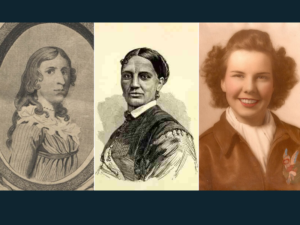 “American women have just achieved a significant milestone,” reports Claire Cain Miller of the New York Times. Women now hold slightly more (50.4 percent) payroll jobs than men. While women passed this milestone once before in mid-2010 during the recession, the economy is now doing well. What has made the difference? Miller explains that
“American women have just achieved a significant milestone,” reports Claire Cain Miller of the New York Times. Women now hold slightly more (50.4 percent) payroll jobs than men. While women passed this milestone once before in mid-2010 during the recession, the economy is now doing well. What has made the difference? Miller explains that
- Male-dominated occupations, like manufacturing, are shrinking
- Female-dominated occupations, like healthcare and education, are growing. Men don’t want these jobs, even when they are higher-paying jobs, like nurse practitioners, that are more secure than many jobs in male-dominated occupations
So what is the problem? The problem for men is that they remain under- or unemployed when they refuse to take healthcare or education jobs. But women are also experiencing a problem. When occupations remain female dominated, the pay remains low and the work is devalued. At the other end of the scale, when women enter fields in large numbers that are traditionally male dominated, the pay declines. Let’s look more closely at what is going on that keeps these gendered dynamics in place.
Miller points out the many reasons for the decline in work for men:
- The rise of automation
- The waning power of unions
- Rising incarceration rates
- Factories that move overseas
- Challenges to switching jobs, like retraining
- Gender norms
The United States economy is now service dominated, which means it is female dominated. Women are 84 percent of social service workers and 78 percent of healthcare workers. The norms of masculinity make it hard for men to take jobs that require feminine skills such as interpersonal finesse or care work. Miller explains that markers of masculinity are having a good-paying job that is about making things (not providing services) and “distancing oneself from feminine things.” Miller cites a study by Margarita Torre Fernández, a sociologist at the University Carlos III of Madrid, using data from the census and the National Longitudinal Study of Youth from 1979 to 2006. She found that men would not apply for jobs in nearly every female-dominated occupation, and “some men would rather endure unemployment than accept a relatively high-paying women’s job and suffer the potential social stigma” for doing so. Miller adds that men who have taken pink-collar jobs in the United States are more likely to be black or Hispanic and have the least education and the lowest earnings. Even though these jobs pay less overall, they often pay more than the jobs that black and Hispanic men had access to previously.
Why are women experiencing success in the labor market? Miller suggests that women’s success has been driven by:
- Educational gains
- More black and Hispanic women entering the workforce
- More flexibility and willingness to retrain
The United States is likely to remain a service economy for the foreseeable future. What would improve conditions for the economic health of both women and men? As Miller notes, researchers suggest “that improving the quality of pink-collar jobs, in terms of wages, stability, benefits and hours . . . could attract both men to these jobs and also benefit women.” If these jobs were more highly valued in our society, men would be more likely to want to enter them and women would benefit from higher wages. Miller closes by saying, “Improving the quality of pink-collar, working-class jobs has the potential to close gender gaps—and also to shrink the widening gaps between the highest and lowest earners, both women and men.”
Photo by National Cancer Institute on Unsplash
 Becoming a caregiver for an adult family member is not uncommon. My sister and I dropped everything to take care of our mother in the last months of her life as her brain tumors advanced and she became helpless. Lorene Cary of the New York Times writes that
Becoming a caregiver for an adult family member is not uncommon. My sister and I dropped everything to take care of our mother in the last months of her life as her brain tumors advanced and she became helpless. Lorene Cary of the New York Times writes that  Intel became the first company in the United States to voluntarily disclose pay, race, and gender data required by the US Equal Employment Opportunity Commission (EEOC). Jeff Green and Hannah Recht, writing for the Los Angeles Times, explain that while the Obama administration required the EEOC to collect 2017 and 2018
Intel became the first company in the United States to voluntarily disclose pay, race, and gender data required by the US Equal Employment Opportunity Commission (EEOC). Jeff Green and Hannah Recht, writing for the Los Angeles Times, explain that while the Obama administration required the EEOC to collect 2017 and 2018  Women are now equally represented in medical school enrollment in the United States. The field of medicine offers some opportunities to women who want to be both doctors and mothers that are not available in other professions. These opportunities, which include flexibility and predictable schedule, are available in some medical specialties but not others. Emma Goldberg of the New York Times writes about the
Women are now equally represented in medical school enrollment in the United States. The field of medicine offers some opportunities to women who want to be both doctors and mothers that are not available in other professions. These opportunities, which include flexibility and predictable schedule, are available in some medical specialties but not others. Emma Goldberg of the New York Times writes about the  Two new studies show that while men are as likely as women to say they need time off from work to care for babies, aging parents, or sick family members, men are less likely than women to take unpaid leave and they take shorter paid leaves than women. Claire Cain Miller of the New York Times notes that both new studies find a
Two new studies show that while men are as likely as women to say they need time off from work to care for babies, aging parents, or sick family members, men are less likely than women to take unpaid leave and they take shorter paid leaves than women. Claire Cain Miller of the New York Times notes that both new studies find a  Whether women are elected to local, state, or national office or are appointed to visible senior roles in federal government, they face more threats and attacks, sometimes physical, than ever before. Adeel Hassan of the New York Times reports that 79 percent of mayors in the United States “
Whether women are elected to local, state, or national office or are appointed to visible senior roles in federal government, they face more threats and attacks, sometimes physical, than ever before. Adeel Hassan of the New York Times reports that 79 percent of mayors in the United States “ Encouraging new research from Lakshmi Balachandra, assistant professor in entrepreneurship at Babson College near Boston, reported by Janelle Nanos of the Boston Globe, identifies
Encouraging new research from Lakshmi Balachandra, assistant professor in entrepreneurship at Babson College near Boston, reported by Janelle Nanos of the Boston Globe, identifies  The Barbara Lee Family Foundation, formed twenty years ago by Barbara Lee to advance women’s equality in politics, is nonpartisan and research based. Lee, described by Stephanie Ebbert of the Boston Globe as “
The Barbara Lee Family Foundation, formed twenty years ago by Barbara Lee to advance women’s equality in politics, is nonpartisan and research based. Lee, described by Stephanie Ebbert of the Boston Globe as “ Women in different parts of the world have both similar and different experiences. Here are some updates from South Korea, Nigeria, Spain, France, and Saudi Arabia on workplace barriers, the #MeToo movement, and domestic violence.
Women in different parts of the world have both similar and different experiences. Here are some updates from South Korea, Nigeria, Spain, France, and Saudi Arabia on workplace barriers, the #MeToo movement, and domestic violence. I find it inspirational to read about women in history who I have never heard of but who have accomplished amazing things. Thanks to attempts in recent years by the New York Times to make amends for not acknowledging these women at the time of their deaths, their belated obituaries are now published from time to time. Here are a few of these women:
I find it inspirational to read about women in history who I have never heard of but who have accomplished amazing things. Thanks to attempts in recent years by the New York Times to make amends for not acknowledging these women at the time of their deaths, their belated obituaries are now published from time to time. Here are a few of these women: